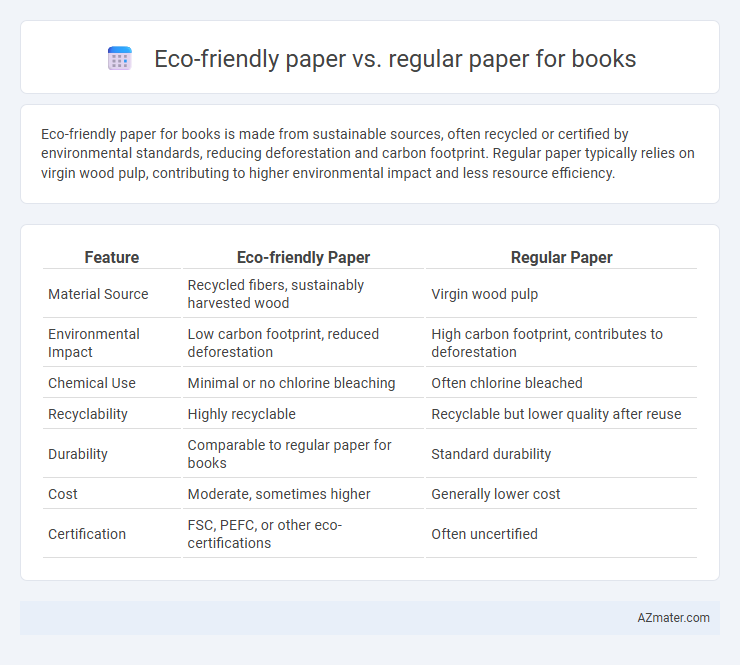Eco-friendly paper for books is made from sustainable sources, often recycled or certified by environmental standards, reducing deforestation and carbon footprint. Regular paper typically relies on virgin wood pulp, contributing to higher environmental impact and less resource efficiency.
Table of Comparison
| Feature | Eco-friendly Paper | Regular Paper |
|---|---|---|
| Material Source | Recycled fibers, sustainably harvested wood | Virgin wood pulp |
| Environmental Impact | Low carbon footprint, reduced deforestation | High carbon footprint, contributes to deforestation |
| Chemical Use | Minimal or no chlorine bleaching | Often chlorine bleached |
| Recyclability | Highly recyclable | Recyclable but lower quality after reuse |
| Durability | Comparable to regular paper for books | Standard durability |
| Cost | Moderate, sometimes higher | Generally lower cost |
| Certification | FSC, PEFC, or other eco-certifications | Often uncertified |
Introduction to Eco-Friendly Paper and Regular Paper
Eco-friendly paper is made from sustainable sources such as recycled materials or certified forests, reducing environmental impact by minimizing deforestation and energy consumption. Regular paper primarily derives from virgin wood pulp, involving higher water use, chemical treatment, and carbon emissions throughout production. Choosing eco-friendly paper supports conservation efforts and promotes a healthier planet by reducing waste and conserving natural resources.
Environmental Impact of Paper Production
Eco-friendly paper significantly reduces environmental impact by using sustainable sources like recycled fibers or certified forests, lowering deforestation rates compared to regular paper derived from virgin wood pulp. Its production consumes less water and energy, resulting in decreased greenhouse gas emissions and pollution. Choosing eco-friendly paper helps conserve natural resources and supports a circular economy in the paper industry.
Raw Materials: Sustainable Sources vs. Conventional Sources
Eco-friendly paper for books is typically produced from sustainable raw materials such as recycled fibers, bamboo, or responsibly harvested wood, reducing environmental impact and promoting forest conservation. Regular paper relies on conventional sources, often involving extensive logging and deforestation, which contributes to habitat loss, increased carbon emissions, and resource depletion. Choosing sustainable raw materials supports circular economy practices and reduces the ecological footprint of book production.
Manufacturing Processes and Carbon Footprint
Eco-friendly paper for books is produced using sustainable raw materials like recycled fibers or rapidly renewable resources, significantly reducing deforestation and water consumption compared to regular paper made from virgin wood pulp. Manufacturing processes for eco-friendly paper often employ chlorine-free bleaching and lower energy consumption, leading to a substantially smaller carbon footprint. Studies indicate that eco-friendly paper production emits up to 50% less CO2 equivalents, making it a more sustainable choice for environmentally conscious publishing.
Energy and Water Consumption Comparison
Eco-friendly paper production consumes up to 60% less energy and reduces water usage by approximately 70% compared to regular paper manufacturing, significantly lowering the environmental footprint. The adoption of recycled fibers and sustainable practices in eco-friendly paper processes minimizes reliance on virgin pulp and decreases water contamination. These efficiencies contribute to more sustainable book publishing, aligning with global efforts to conserve natural resources.
Chemicals and Additives in Eco-Friendly vs. Regular Paper
Eco-friendly paper is produced using fewer harmful chemicals and additives compared to regular paper, often employing natural bleaching agents like oxygen or hydrogen peroxide instead of chlorine-based compounds. Regular paper typically contains chlorine and other toxic substances that contribute to environmental pollution and health risks during manufacturing and disposal. The reduced chemical usage in eco-friendly paper minimizes the release of dioxins and other hazardous byproducts, making it a safer choice for book production and sustainability.
Durability and Quality for Book Publishing
Eco-friendly paper in book publishing offers comparable durability to regular paper, often featuring higher tensile strength due to recycled fibers and sustainable processing methods. Its quality maintains sharp print clarity and vibrant colors, meeting industry standards while reducing environmental impact. Regular paper may sometimes provide a smoother finish but lacks the sustainability credentials that eco-friendly alternatives deliver without compromising longevity.
Cost Analysis: Eco-Friendly Paper vs. Regular Paper
Eco-friendly paper generally incurs higher upfront costs than regular paper due to sustainable sourcing and manufacturing processes, though it can offer long-term savings through potential tax incentives and reduced environmental impact fees. Regular paper remains cheaper in bulk production and is widely available, making it cost-effective for large print runs. Evaluating cost analysis involves factoring in not only price per unit but also sustainability benefits that may enhance brand value and meet regulatory standards.
Consumer and Publisher Preferences
Eco-friendly paper, made from recycled fibers or sustainably sourced materials, appeals to environmentally conscious consumers and publishers prioritizing sustainability and corporate social responsibility. Regular paper, often produced from virgin wood pulp, generally offers lower production costs and brighter print quality, attracting publishers focused on budget efficiency and mass-market appeal. Consumer preferences increasingly favor eco-friendly options for their reduced environmental impact, while publishers balance cost, print quality, and market demand in choosing paper types.
Conclusion: Choosing the Right Paper for Sustainable Publishing
Eco-friendly paper, made from recycled materials or sustainably sourced fibers, significantly reduces environmental impact compared to regular paper produced from virgin wood pulp. Selecting eco-friendly paper for book publishing supports forest conservation, lowers carbon emissions, and promotes a circular economy. Prioritizing sustainable paper choices aligns with green publishing goals while maintaining print quality and durability.

Infographic: Eco-friendly paper vs Regular paper for Book
 azmater.com
azmater.com